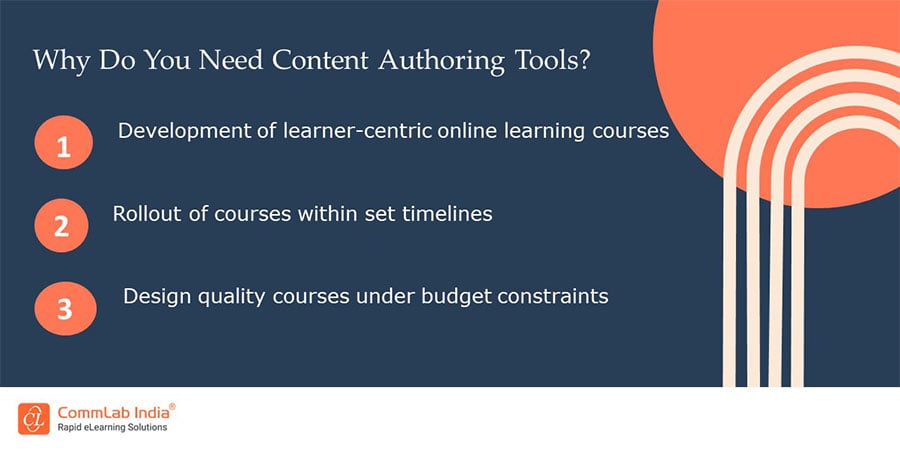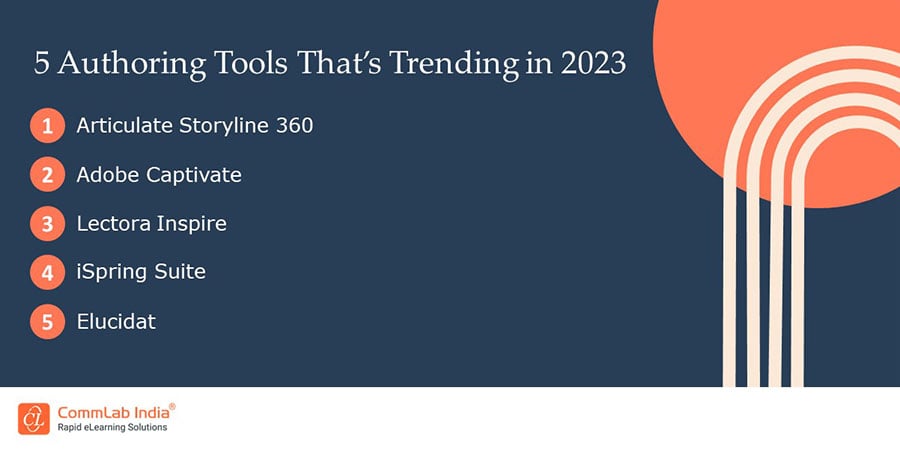6 Key Points to Consider When Selecting the Right Content Authoring Tool

Are your corporate training initiatives bringing you the desired results? Do your online training courses offer immersive learning experiences to your learners? Well, if you are concerned about the effectiveness of your eLearning courses, it’s time to consider the idea of choosing the authoring tool that’s just right for you. Content authoring tools or eLearning authoring tools are an integral part of the online course development process that can help you create awesome learning content for your learners, win an edge over competitors, and boost business ROI. If you need help in choosing the content authoring tool that fulfils your workplace needs, this blog can help you with the key considerations you should keep in mind while choosing an eLearning authoring tool.
Content Authoring Tools are Crucial to Designing Learner-Centric eLearning
Here are a Few Key Considerations to Select the One That’s Just Right For You:
- Meets your training needs
- Offers ease of use
- Ensures scalability and offers flexibility
Read on to explore more.
Why Do You Need a Content Authoring Tool?
Well, the paradigm of corporate training is slowly drifting from conventional classroom training to digital learning. Learner engagement is a major pain point when it comes to online training. You need courses that appeal to the learners. Boring PowerPoint presentations and text-heavy eBooks are a strict no-no in today’s dynamic world.
Businesses are striving to match the ever-evolving customer needs and preferences and embracing innovation. This has led to the increased need for training your employees to build a future-ready workforce. eLearning can fulfil all your learners’ needs and content authoring tools play a key role in designing learner-centric courses within set timelines and tight budgets.

6 Key Considerations While Choosing the Right Content Authoring Tool
There are many authoring tools on the market today with varied features. Some offer ease of use and speed to develop and roll out courses fast, whereas there are others that enable better workflows to meet your business needs. Then there are tools that offer content management and better collaboration while others allow easy integration with third-party tools. Amidst all these tools that offer catchy and worthy features, selecting the one that’s just right for your workplace learning needs and aligns with your business goals is not easy.
Choosing the right content authoring tool will certainly have an impact on the effectiveness of your online training initiatives and the business results. Here are a few key considerations to make note of while you hunt for the tool that’s just right for you. See if the tool:
1. Meets Your Training Needs
Every training doesn’t need eLearning. Sometimes, a video or a virtual instructor-led training (VILT) session serves the purpose. Before investing in a content authoring tool, a thorough training need analysis is a must. Ask yourself whether eLearning is the best approach to deliver training on the given topic. If yes, whether your eLearning needs to be simple, entailing images and graphics or you need to design advanced interactivities. What learning outcomes are you planning to accomplish and how are you planning to showcase that you met the desired objective?
With a clear understanding of your organization’s training needs, you will be in a better position to review the features and functionalities of the tool and see if it meets your current and future project needs.
→ Access Tool: Authoring Tool Finder
2. Offers Ease of Use
If you are new to implementing eLearning in your organization and are planning to design and develop the courses in-house, you must be looking for a tool that’s easy to use. Check how user-friendly the tool is and whether non-technical authors can easily create and publish courses without the pain of complex coding. It is also important for the content authoring tool to have a short learning curve so that much time is not invested in training your team to learn how to use the tool. After all, you are banking on the authoring tool to create courses on time and facilitate continual learning at your organization.
3. Ensures Scalability and Offers Flexibility
The basic objective to invest in an eLearning authoring tool for any organization is to gain scale and speed. Look for an authoring tool that ensures scalability and at the same time offers flexibility. It is tempting to make decisions based on the current training needs, but one should always consider future requirements. After all, an authoring tool is a long-term investment for any organization and thus requires a detailed analysis of certain parameters.
In this rapidly changing world, it is important to have an authoring tool that scales up to the advancements. You should check whether your tool is template driven or offers you the scope to customize them as per your changing business needs or create your own layouts and templates. Just because you are a beginner and do not aim for advanced courses doesn’t mean you would stay behind from catching up with the upcoming eLearning trends in the coming years. So invest in a tool that supports a wide variety of learning formats like scenarios, mobile learning, gamification, and virtual reality (VR). Also, the tool that you consider should support multilingual translations to ensure training to your global workforce with equal fervor.

4. Facilitates Seamless Collaboration
The design and development of an eLearning course involve multiple stakeholders. The entire team consisting of content creators, instructional designers, subject matter experts (SMEs), and eLearning developers should be close-knit to ensure the timely rollout of online training courses. For this seamless collaboration between all the stakeholders is crucial.
So, it’s wise to choose a cloud-based, device-agnostic eLearning authoring tool that offers flexibility to work from anywhere, anytime, and on any device of choice. Investing in a cloud-based authoring tool not only comes with features that support creating, uploading, reviewing, and updating eLearning courses but also save you the trouble of installation on individual systems and continual feature upgrades. The built-in online review tool allows multiple SMEs to provide feedback on the course ensuring no duplicate comments. It is also convenient for the design and development team to work on the suggested changes and for the SMEs to review the changes as everything is happening in real time. This automatically leads to a quick roll-out of courses without compromising on the quality.
5. Enables Adaptive and Responsive Course Development
Great eLearning courses drive learner engagement and offer immersive learning experiences. And authoring tools are meant to add that spark to your eLearning courses with awesome interactivities and engaging assessments. Decide upon what kind of learning you want to create. Then look for the features and functionalities in the tools to match your training needs. Trends come and go. And it’s true for eLearning too. Make sure you invest in a tool for the long haul and not get carried away with passing fads.
As you ace the game of eLearning design and development, you might look forward to creating more complex interactivities. Check whether the tool that you are considering has the features to design advanced interactivities, engaging assessments, and gamified courses. With the rise in the popularity of mobile learning, creating a mobile-friendly responsive course is no more an afterthought. To ensure an optimal user experience for your global learners across multiple browsers and devices, choosing a content authoring tool with responsive design capabilities should be your top consideration.
6. Allows Easy Integration with LMS for Publishing and Tracking
It is not only important to design and develop an eLearning course but publishing the course in the desired formats for multi-device compatibility is a crucial requirement. Most authoring tools publish the content in SCORM, AICC, or xAPI (formerly known as TinCan) formats which can be imported into an LMS from where it can be accessed by your learners. You should also ensure that the output is published in HTML5 format for the course to be mobile-compatible.
In order to measure the effectiveness of your eLearning courses your authoring tool should allow you to use xAPI statements to track learner behaviour with or without the LMS. This would help you identify gaps if any and revise the eLearning course modules for improved learning.
Watch this video to know about 5 popular content authoring tools in 2023.
Bottom Line
Authoring tools are a training manager’s best friend as they help roll out of online training courses under tight budgets and stringent deadlines. It is important to have a detailed training need analysis and then choose the content authoring tool to match your requirements. Hope the above-mentioned tips help you weigh the wide variety of tools available in the market and choose the one that best suits your learner and organizational needs and bring you desired business outcomes and improved ROI.
To help you in your journey, here’s an authoring tool finder that can guide you to choose the best content authoring tool. Access the tool now!




![Choosing an eLearning Vendor Made Easy [Infographic]](https://blog.commlabindia.com/hubfs/Imported_Blog_Media/choosing-elearning-vendor-infographic-1.jpg)
![Why is Rapid eLearning the Right Choice in Corporate Training? [Infographic]](https://blog.commlabindia.com/hubfs/Imported_Blog_Media/rapid-elearning-investment-reasons-info.jpg)